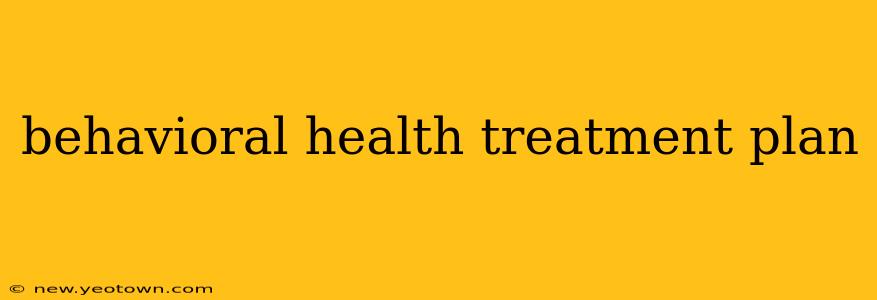The path to improved mental and emotional well-being isn't a straight line; it's a journey, often winding and challenging, but ultimately rewarding. A well-structured behavioral health treatment plan acts as your compass and map, guiding you toward a healthier, happier you. This isn't a one-size-fits-all solution; individual needs vary greatly, requiring personalized plans tailored to specific circumstances. Let's explore the key components that make a successful treatment plan.
What is a Behavioral Health Treatment Plan?
A behavioral health treatment plan is a detailed document outlining the strategies and interventions a healthcare professional designs to address an individual's mental health concerns. It's a collaborative effort, with the individual actively participating in setting goals and choosing the approaches that best suit their needs and preferences. This plan isn't static; it evolves over time, adapting to progress and any changes in circumstances.
What are the Key Components of a Behavioral Health Treatment Plan?
Several critical elements contribute to a comprehensive and effective behavioral health treatment plan. These include:
-
Assessment and Diagnosis: The journey begins with a thorough assessment of your mental health, including a comprehensive evaluation of symptoms, history, and current life circumstances. This assessment is crucial for an accurate diagnosis, guiding the selection of appropriate interventions.
-
Goals and Objectives: Clearly defined, measurable, achievable, relevant, and time-bound (SMART) goals are paramount. These goals should reflect your aspirations for improvement and recovery. These might encompass reducing anxiety, improving sleep, enhancing coping skills, or strengthening relationships.
-
Interventions and Treatments: The plan outlines specific interventions selected based on your diagnosis and goals. These might include therapy (e.g., Cognitive Behavioral Therapy (CBT), Dialectical Behavior Therapy (DBT)), medication management, support groups, lifestyle changes (like improved diet and exercise), or a combination of these approaches.
-
Treatment Modalities: The treatment plan will specify the frequency, duration, and setting of your treatment sessions. This might include individual therapy, group therapy, family therapy, or telehealth sessions.
-
Progress Monitoring and Evaluation: Regular progress monitoring is vital to ensure the treatment plan is effective and to make necessary adjustments. This often involves ongoing assessments, tracking of symptoms, and feedback sessions.
-
Contingency Planning: Life throws curveballs. A good treatment plan incorporates a contingency plan to address potential setbacks or crises. This might include strategies for managing triggers, relapse prevention plans, and crisis contact information.
-
Collaboration and Communication: Effective treatment plans are built on collaboration. Open communication between the client, therapist, and other healthcare professionals is crucial for mutual understanding and shared decision-making.
What Types of Therapy are Included in a Behavioral Health Treatment Plan?
Cognitive Behavioral Therapy (CBT)
CBT focuses on identifying and changing negative thought patterns and behaviors that contribute to mental health challenges. It's a highly effective approach for various conditions, including anxiety disorders, depression, and PTSD.
Dialectical Behavior Therapy (DBT)
DBT is particularly helpful for individuals struggling with borderline personality disorder and emotional dysregulation. It teaches coping skills for managing intense emotions and improving interpersonal relationships.
How Often Should I Meet with My Therapist?
The frequency of therapy sessions depends on individual needs and the severity of the condition. Some individuals may benefit from weekly sessions, while others might require more frequent or less frequent meetings as they progress. This will be determined collaboratively with your therapist.
What if My Treatment Plan Isn't Working?
If you're not seeing progress or feel your treatment plan isn't addressing your needs effectively, open communication with your therapist is essential. Together, you can explore alternative approaches, adjust goals, or consider additional interventions. Remember, a successful treatment plan is a dynamic process that evolves with your needs.
Conclusion: Your Journey to Wellness
Creating a behavioral health treatment plan is an empowering step towards improving your mental and emotional well-being. Remember, this is a collaborative process, and your active participation is crucial for success. By working closely with your healthcare team, you can navigate this journey, overcome challenges, and build a healthier, happier life.

